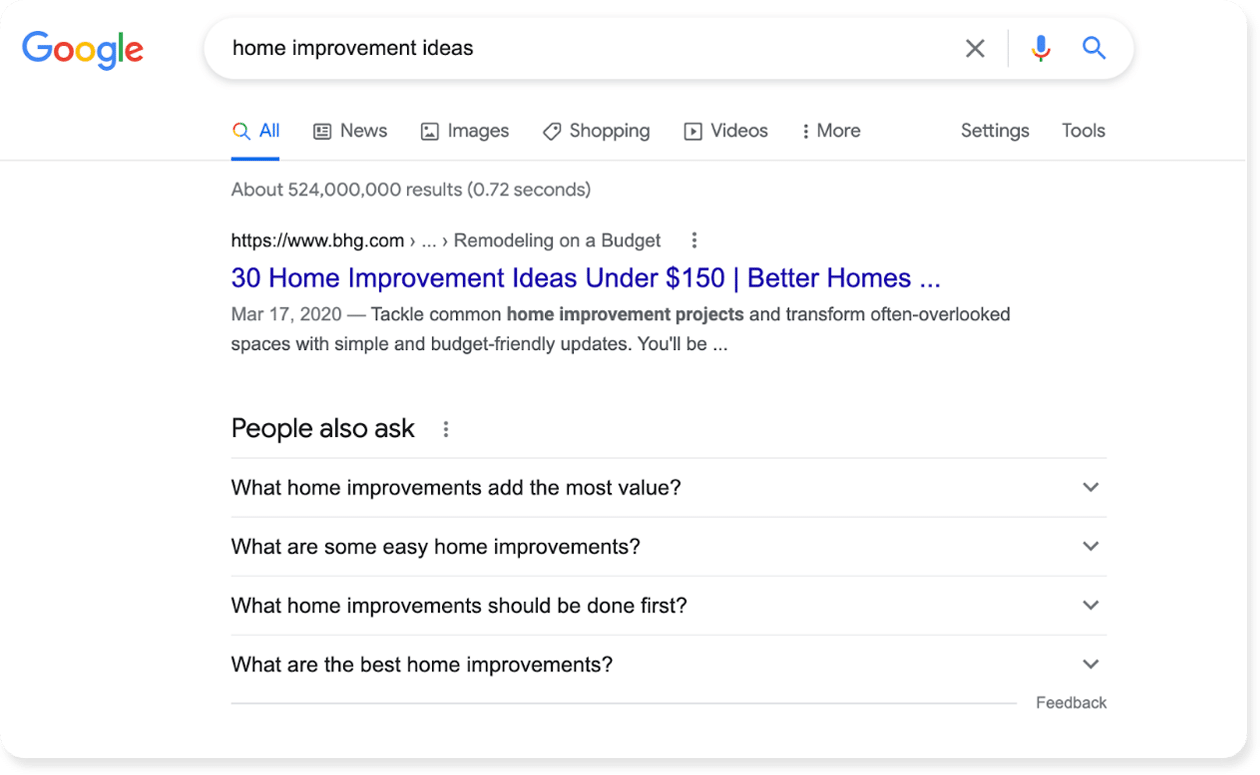Why Is High-Quality Content Important If You Want To Rank On Google?
News flash: your content is one of the most important tools you have, and if you’re not paying attention to it, you’re missing out on a huge opportunity to attract more customers and make more money.
Think about it, content is the only way you can communicate your message, educate your readers, and build a connection with your target audience – and we’ll show you how to make it.
If you want your content to really reach your audience and translate into a bigger, better business, it needs to rank on the first page of Google (and preferably in one of the top three spots).
Why? Over 92% of all online traffic comes from Google, and nearly 75% of people only click on one of the top three results to get the information they’re looking for.
Translation: if you’re not high on that first page, your content’s basically being thrown into the abyss. Not to mention the fact that you’re setting yourself up for lower trustworthiness and brand authority in the eyes of your customer.
That said, just because ranking on Google is important doesn’t mean it’s easy. And stuffing your page with keywords and search terms won’t rank your page up like it did 10-15 years ago (Google’s too smart for that now).
Instead, the best and only place to start is by creating truly high-quality, optimized content. Here’s why it’s so important and how to get it right.

What Does “Content” Mean?
Before we dive into the details, it’s important to establish what we mean when we use the terms “content” and “content marketing.”
Put simply, content is anything that uses words to convey a message to your customers.
Your website copy, your social media captions, your blogs, your paid ads, your emails, your graphics, your videos — it’s all content. And there are many forms and subsets of content marketing, including:
- Social media marketing, which should be informed by a strong content media strategy
- Paid advertisements (PPC)
- Inbound marketing which includes helpful blogs, emails, and website copy and are all key to bringing more traffic and leads
- Press release (PR) strategy, which should address issues that readers really care about.
- SEO and content creation, which focuses specifically on optimizing for Google.
- Visual content marketing, like infographics, images, and videos
The goal with all of this content marketing is to create and distribute valuable, relevant, and consistent content to attract and retain a clearly defined audience — and, ultimately, to drive profitable customer action.
The most important word here is relevant.
Unlike other “traditional” marketing tools which aim to sell to the customer (think traditional glossy advertisements shouting out features or touting celebrity endorsements), modern content marketing aims to provide the customer with truly relevant, interesting, and helpful information to solve their issues, build trust in your brand, and keep them coming back to you.
And it really works, all leading to:
- Increased sales: Total content marketing revenue will soon exceed $300 billion.
- Cost savings: Content marketing costs 62% less than traditional outbound methods, yet it generates three times the number of leads.
- Increased customer loyalty
In fact, businesses that use content marketing have conversion rates that are six times higher on average than those who do not and 60% of marketers say content marketing is very important or extremely important to their overall strategy.

10 Reasons Why Content Is Important For Your Business
Here are 10 unavoidable reasons why high-quality content is important for your business, along with a few Tradie Digital tips to get your content creation right.
#1 – Content is the foundation of your marketing efforts
As we mentioned, every single piece of content you create — including your emails, ads, social media posts, website content, and blogs — will contain some form of content. And if that content is confusing, lackluster, or less than compelling to your audience, your entire business will suffer.
Why? Because customer experience expectations are higher than ever, and today’s customers expect ultra-personalized, relevant content during every brand interaction they have.
What’s more, businesses that use content well earn 6x more conversions than those that don’t. So if your content misses the mark, or doesn’t seem right for the customer, they’ll leave.
To combat this, it’s important that you understand who you’re talking to and create relevant, interesting content that is:
- Strategic in approach
- Consistent in distribution
- Made for a clearly defined audience
- Educational rather than promotional
- Created to drive profitable customer action
Get this right, and you’ll see more success with every one of your marketing efforts.
#2 – Good content answers questions and creates a thirst for more good content
The good news? You don’t have to convince your customers that your content could be valuable.
People naturally look to find information that answers their question or piques their interest, and companies that have a blog see an average of 67% more leads every month.
In other words, your customers want to have a conversation with you, and they appreciate when you provide them with a forum to do so.
Again, this is all about providing your customers with the information they want to know.
Don’t know where to start? Try Googling your area of expertise and seeing what the search engine has to say.
For example, if you Google “home improvement ideas,” you’ll see a few questions in the “People Also Ask” section, including:
- What home improvements add the most value?
- What are some easy home improvements?
- What home improvements should be done first?
- What are the best home improvements?

You’ll also see a blog covering ‘21 Home Improvement Ideas on a Budget’.
This is the type of information people want to know!
It’s also the information that Google sees as valuable to people who are searching about home improvement ideas. So, if your blog effectively and completely answers these questions, you will both engage effectively with your customers and improve your site’s authority in the eyes of Google.
It’s a win-win, and it’s easy to do.
#3 – Content educates your audience
Your audience will always want to learn something new about your product or service no matter your industry. They also want to work with someone who seems like an expert and emanates trust and authority. This is especially the case when it comes to contractors and home improvement businesses.
Think about it: everyone has a “bad contractor” story that seems to have scarred them or a loved one for life, and people really don’t want to risk their money or their homes.
Use your content to address these concerns head-on, to establish your authority, and to show them that you’re not like those other guys. And you don’t have to achieve this through long-form content. Instead, you could start doing regular social media posts or short videos that explain, for example, how to nail a picture the right way or how to tell if you’re dealing with a bad contractor on the spot.
Create this content regularly and you’ll have better rankings and more loyal customers.
#4 – Content helps you build backlinks
We’re not going to get too technical here, but if you want your content to rank on Google, you need to have links. More specifically, you’ll need internal links and external links.
Here’s a quick refresher:
Internal links: These are links to other pages on your website. For example, if you run a landscaping site and you’re writing a blog on where to put a pool, you should add links within your blog to other articles on the topic of pool construction and pool care, and to services pages covering pool landscape design.
Overall, this kind of internal linking will help boost your site’s authority by showing Google that you know what you’re talking about and that you’ve covered topics in other places.
External links: These are links to other websites, like the links to statistics you see in this blog. If you earn links from high-authority sites like Home Depot or the top ranking results on Google, it can help build trust in your site quickly.
As a rule of thumb, you want at least three internal links on any given blog or website page. And the more pieces of content you have, the more you can build the authority of your site and your links.
This last point is really important, because you never want to feel like a statement is coming out of nowhere. It’s quite intuitive if you think about it. Say you just started offering a new product, like a shovel. Well, if you’ve never talked about shovels, digging, or landscaping before, it’ll be hard for your customers and Google to feel like you know what you’re talking about.
On the other hand, if you have 15 pieces of content on all things shovel-related, the product will fit in well with your overall brand and the trust will come easily.
In short, you always want a spider web of links going between your pages and to authoritative sites. And if you don’t have a web, you should get spinning where you notice the gaps.
#5 – Good content helps establish you as an industry expert
We’ve touched on this already, but it deserves its own point. For one, 61% of customers prefer a brand with content, and most customers prefer to buy from a company that has content and consistent communication with its audience– so, if you want to be the go-to brand in your customers’ eyes, you need authoritative copy on your site.
That said, the importance of content doesn’t stop at the customer.
If you ever hope to lead your industry and be the “go-to”, you need content to help that happen.
Say, for example, that you go to a trade show and you tell some journalists that your company is the best in town for your product or service. Then, they go to your website and they don’t see much. Your competitor, on the other hand, has a site full of customer reviews, how-to articles, explainer videos, and other helpful pieces of information.
Do you think the journalist will believe you?
Probably not. That’s why you need to think about your content as a resume or portfolio for anyone that’s looking and add information accordingly.
#6 – Content will help your customers find you on Google
We already mentioned that nearly 75% of customers click on the first three results on Google – and 93% stick to the first page. So that’s really where you want to be if you want to get their attention.
But how do you get there?
Well, it can be tough and you may need to hire an expert to help your content rank. That said, you can start by looking at what’s already on Google and one-upping what you see.
For example, if you’re writing about how you’re the “best contractor in Los Angeles,” start by Googling that term.
Look at what you see on Google’s result page.
What questions are people asking? What kind of content is ranking? What’s the title on those pages?
Answer these questions and include all those elements.
Next, look at the top three search results.
What kind of content do they have? What details do they mention? What keywords do they use?
Your information must be on par with theirs, if not better, if you hope to rank. And remember, once your page goes live, you should always keep an eye on how it’s performing and optimize accordingly.
If you want to get the word out about your content, you should be sharing it on social media.
Why? Because 71% of consumers who have had a good social media experience with a brand are likely to recommend it to others and 57% of social browsers use social media to research products.
In short, customers are looking for you there, and if they enjoy their social media interaction with your business, you’ll likely get more than one customer as a result.
There are numbers to back this up, too: Almost 90% of marketers say their social marketing efforts have increased exposure for their business, and 75% say they’ve increased traffic.
Creating regular content is an easy way to keep up with your social media posts. Here are some tips to getting started:
- Come up with a schedule and post regularly: Social media is all about consistency, so figure out a posting schedule and stick to it, rain or shine. You can use some scheduling tools to help you here, like Buffer or Hootsuite.
- Respond to the comments: Customers expect to hear from you, yet 89% of social media messages to brands go ignored. If you’re in that 11% minority, then, you’ll stick out to your customers in all the right ways.
- Stick to one or two platforms: Figure out what social media platforms your customers are on and post there. You don’t want to be a jack of all trades and a master of none, and it makes no sense to post on LinkedIn if all your customers are on Facebook.
#8 – Content increases conversion rates
Content marketing is the key to more conversions and more sales. In fact, content marketing is proven to be 3 times more efficient in terms of leads than outbound marketing.
What’s more, having relevant, interesting content on your site can increase customer loyalty and help you retain long-term customers. This can also translate to long-term savings: retaining a customer is between 5-25X less expensive than acquiring a new one.
So, if you follow all the tips above, you’ll see immediate and long-term improvements in your conversions.
#9 – Informative online content is in high demand
Almost 80% of Internet users read some type of blog, and they’re looking for information that’s personalized, relevant, and ultra-informative. That said, they’re also dealing with an online information overload, and they’re sick of seeing information that’s low-quality and repetitive.
This is super important to keep in mind. If you stick to the status quo and the same basic information that everyone else is sharing, your content won’t stick out in the eyes of your customer.
That’s why it’s important that you dig deep and focus on the relevancy and the quality of your content. The more detailed and informative the content, the more you’ll stick out.
For example, if you run a landscaping business in Australia, you could write articles that are super specific to your area and your customer, like:
- 10 Ways to Protect Your Landscaping Against the Australian Sun
- How to Find the Best Landscaper In Perth in 5 Simple Steps
- How to Save Water [While Still Having A Lush, Green Yard]
To get this right, you could start by sending out a survey to your customer base asking them about their interests, the information they’re looking for, and what they think is missing online.
You’ll be able to create better content, and your customers will likely appreciate that you care enough to ask them what they want to see more of.
#10 – Content yields SEO results
If you have good SEO, you’ll really be writing content all the way to the bank.
What does that mean exactly? Well, SEO is the process of ranking for Google and content is your vehicle.
The goal here is to get Google to recognize your website as an authoritative, high-value place. That way, they’ll put your blogs and website pages on the first page of results — and you’ll get more views.
And getting this right really works. On average, SEO leads have a 14.6% close rate, while outbound leads (such as direct mail or print advertising) have a 1.7% close rate. And this is traffic that you don’t have to pay for and that won’t go away quickly.
Translation? More money and conversions for you.
Content is key to a thriving (and profitable) online presence
Alright, let’s wrap this up and be on our way.
Yes, content can be difficult to create, and it may not seem like it’s worth the effort when you have the immediate satisfaction of paid ads or in-store customers to worry about.
That said, there is nothing as compelling or as cost-effective as great content, and it’s the one marketing strategy that will bring your business results for years to come.
If you’re ready to get started, remember that it’s all about understanding your customers and writing consistent, interesting information that’s actually relevant and helpful to them. That is the number one starting point, and a sure way to begin seeing success in today’s digital world.
Need some help creating winning content? Check out our SEO services and learn how we can get your content optimized and bring you new customers.







